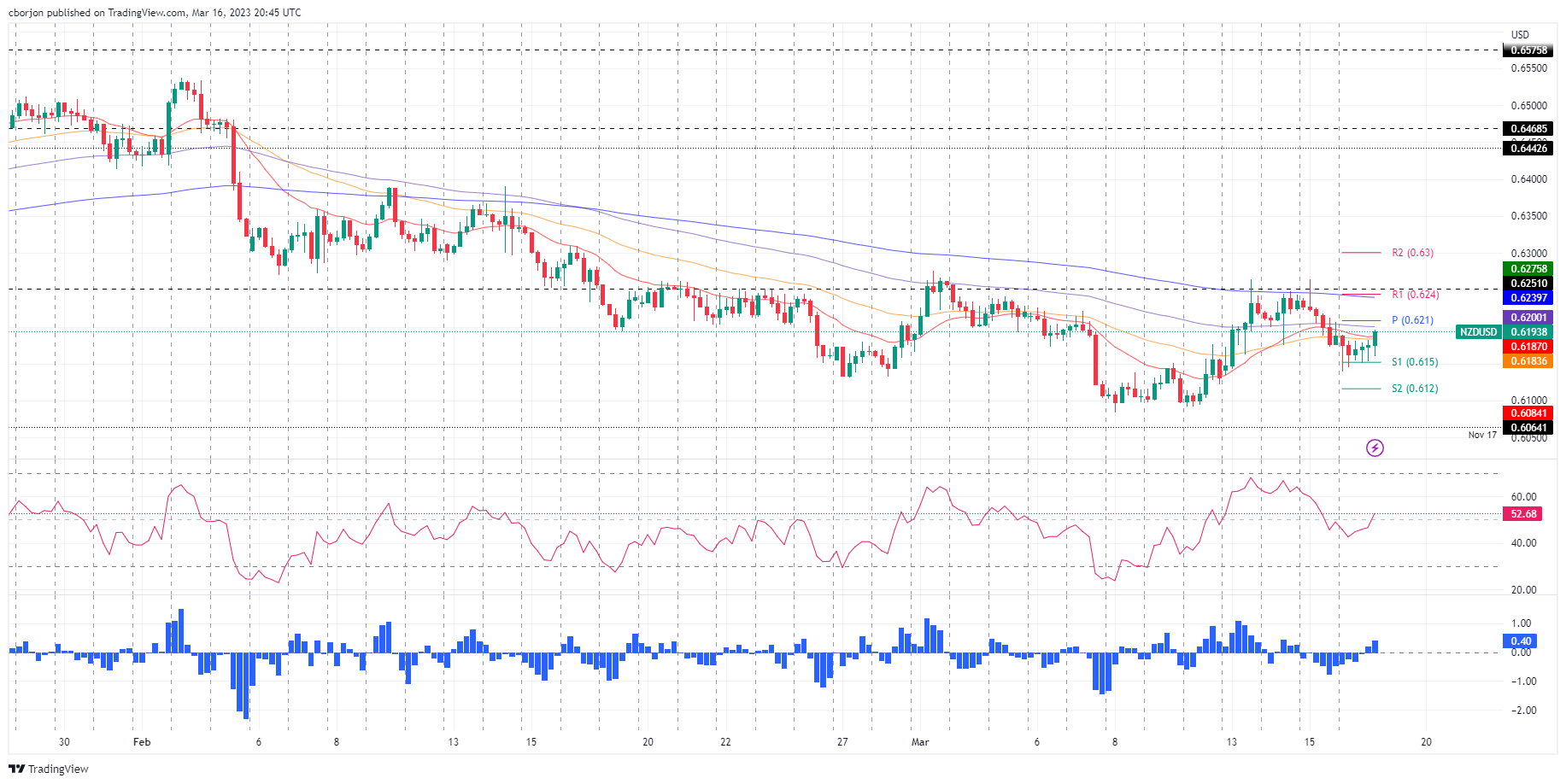- Analytics
- News and Tools
- Market News
- NZD/USD firm around 0.6190s with buyers eyeing the 200-DMA, ahead of US Consumer Sentiment
NZD/USD firm around 0.6190s with buyers eyeing the 200-DMA, ahead of US Consumer Sentiment
- NZD/USD is subdued, around the 0.6190s ahead of Friday’s US economic data.
- A risk-on impulse spurred the NZD/USD’s bounce from daily lows despite printing bad NZ GDP data.
- NZD/USD Analysis: Short-term is upwards, though a break above 0.6200 will poise the pair towards the 200-DMA.
NZD/USD is about to finish Thursday’s session flat after diving towards a daily low of 0.6139. The European Central Bank (ECB) lifted rates amidst turbulent times. However, news that Swiss authorities backed Credit Suisse and major US banks stepping in to help First Republic Bank eased investors’ fears. Therefore, the NZD/USD recovered and is trading at 0.6191, a gain of 0.06%.
Sentiment improvement, the excuse for NZD buyers to lift the exchange rate
Wall Street finished with gains between 1.12% and 2.48%. Employment data in the United States (US), delivered by the Bureau of Labor Statistics (BLS), showed that unemployment claims for the last week rose by 192K below estimates of 205K, less than the prior week’s 212K. In the meantime, housing data like Building Permits and Housing Starts came above estimates and the prior’s month data.
At the same time, the Philadelphia Fed revealed that manufacturing activity contracted at a slower rate in March.
In the meantime, the US Dollar Index, a measure of the buck’s value against a basket of six currencies, losses 0.30%, at 104.430, a tailwind for the NZD/USD.
Earlier in the Asian session, the New Zealand Dollar (NZD) weakened on the release of the New Zealand (NZ) Gross Domestic Product (GDP) for Q4, which contracted 0.6% QoQ, and below the Reserve Bank of New Zealand (RBNZ) MPS projection of 0.7% expansion.
Analysts at ANZ Bank said, “the record Q4 current account deficit, amid waning appetite for NZGBs, the Kiwi may face headwinds in coming weeks. A Fed hike and/or higher dot plots next week, alongside reduced financial instability, may also see markets become more positive on the USD.”
What to watch?
The NZ economic docket is empty toward the end of the week. In monthly and annual readings, the US calendar wil feature Indutstiral Production for February. The MoM figures are estimated at 0.2%, above January’s 0%. In addition, the University of Michigan (UoM) Consumer Sentiment poll will update American sentiment regarding the economy and revise inflation expectations.
NZD/USD Technical analysis
The NZD/USD 4-hour chart portrays the pair bottomed around the 0.6120 area. On Thursday’s session, the pair’s low was around the S1 daily pivot, used as a springboard, with prices rising towards the confluence of the 20 and 50-Exponential Moving Averages (EMAs) at 0.6183-87. A breach of the 100-EMA at 0.6200 and the NZD/USD might test the 200-EMA in the near term at 0.6239. Otherwise, an NZD/USD fall beneath 0.6139, and the 0.6100 would be up for grabs.

© 2000-2024. All rights reserved.
This site is managed by Teletrade D.J. LLC 2351 LLC 2022 (Euro House, Richmond Hill Road, Kingstown, VC0100, St. Vincent and the Grenadines).
The information on this website is for informational purposes only and does not constitute any investment advice.
The company does not serve or provide services to customers who are residents of the US, Canada, Iran, The Democratic People's Republic of Korea, Yemen and FATF blacklisted countries.
Making transactions on financial markets with marginal financial instruments opens up wide possibilities and allows investors who are willing to take risks to earn high profits, carrying a potentially high risk of losses at the same time. Therefore you should responsibly approach the issue of choosing the appropriate investment strategy, taking the available resources into account, before starting trading.
Use of the information: full or partial use of materials from this website must always be referenced to TeleTrade as the source of information. Use of the materials on the Internet must be accompanied by a hyperlink to teletrade.org. Automatic import of materials and information from this website is prohibited.
Please contact our PR department if you have any questions or need assistance at pr@teletrade.global.















